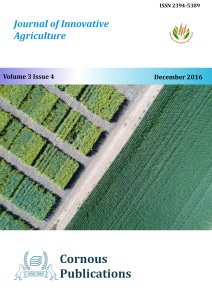
Journal of Innovative Agriculture
Peer Reviewed Open Access Journal
ISSN: 2394-5389 NAAS Rate: 4.05
Submit Manuscript
Peer Reviewed Open Access Journal
ISSN: 2394-5389 NAAS Rate: 4.05
Submit ManuscriptColour is an inherent property of foods and it enhances the delicacy of food not only provide flavor and delight appearance, but it also provides information on quality and condition of the food products. The synthetic colours are toxic and they have proved to be harmful to human health and also make it undesirable for human consumption. Consumer awareness and growing concern over the safety aspects of synthetic colours have put the pressure on food processors to adopt natural colours, which are considered to be safe to the consumer. Therefore the attention of food industry has turned to use synthetic colours in food products. Natural food colours are generally extracted from fruits, vegetables, seeds, roots and microorganisms. Natural food colours protect food from oxidation by enzymes. Therefore, they not only enhance the appearance and flavor to the food but also protect the food from oxidation. Many natural colorants are rich in nutrients and antioxidants and their presence in the diet reduces the risk to many diseases. The present study was conducted to extract the bio food colour powder from elephant foot yam by using spray dryer. The colour was extracted with water and acetone as a solvents, different level of maltodextrin (15, 20 & 25%), drying termperature (160, 180 and 200oC) and flow rate (25 & 30 ml per min). The yield recovery 9.3g/100ml was maximum at 180ºC with a flow rate of 25 ml / min at 25 % maltodextrin. The colour value L* was found to be 181.05, a* - 9.33and b* was found to be 56.06. The powder was sensory evaluated and sensory score was recorded as 8.2 thus, natural colorants from foot yam which are rich in nutrients, antioxidants and their presence in the diet reduces the risk to many diseases.
Foot yam, spray drying, flavoured milk, maltodextrin, sensory score
AOAC, 1995. Official methods of analysis of the association of official chemistry, 16th (eds) Washington : 235.
Eliana F. O. Pavlo, C. S. and Mitton, C.C. 2007. Stability of anthocyanin in spinach vine (Basella rubra) fruits. Ciencia Investigation Agrarian, 34(2): 85-90.
Goula, A. M. and Adamopoalos, K. G. 2005. Stability of lycopene during spray drying of tomato pulp LWT. Food Science and Technology, 38: 479-487.
Gristina, G, Pilarz, Francisco and Tomas, B. 1998. The use of acetone as an extraction solvent for anthocynanins from straw berry fruit. Phytochemical analysis, 9: 274-277.
Hathorn, C. S. M.A. Biswas, P. N. Girchuhi and A. C. Benjamin, 2006. Comparison of chemical, physical micro structural and microbial properties of bread supplemented milk sweet potato flour and high gluten dough enhancer. Science Direct., 41: 803-815.
Hung, H. C. K. J. Joshipura, R. Jiang, P. B. Ho, D. Hunter and S. A. Smithwarner. 2004. Fruit and vegetable intake and risk of major chronic diseases. Journal of National Cancer Institute, 96(II): 1577-1584.
Jackson, L. S. K. Lee. 1991. Micro encapsulation and the food industry. Lebensumwiss. Technology, 24: 289-293.
Roy, K., Swathi Gullapalli, Utpal Roy Chaudhuri and Runuchakraberty. 2004. The use of a natural colourant based on betalain in the manufacture of sweet products in India. International Journal of Food Science and Technology, 39: 1087-1091.
Kalalingam, 2003. Processing and evaluation of fruit based eggless instant cake mix Ph.D. Thesis submitted to Department of Food Science and Nutrition. Home Science College and Research Institute, TNAU, Madurai.
Kanparo, K. Usawakesmanee, W and Sirivogpaisal, P. and S. Siripongvutikorn (2012). The compositions and properties of spray dried tuna flavor powder produced from tuna pre cooking juice. International Food Research Journal, 19(3): 893-899.
Mazza, G. 2000. Health aspect of natural colour. In natural food colourants. Science and Technology, New York, P. 289-314.
Nuzhet Turkes and Ferruch Erdogdu. 2006. Effect of pH and temperature of extraction medium on effective diffusion co efficient of anthocyanin pigments of black carrot. (Daucus carota va. L.) Journal of Food Engineering, 76: 579-583.
Parvathi, S. and Subbulakshmi, B. 2016. Development of value added products from tropical tubers. Journal of Crop and Weed, 12(1): 69-75
Reddy, M. K. Alexander, L. R. C and Nair, M. G. 2005. Relative inhibition of lipid peroxidation cyclooxygenase enzymes and human tumor cell proliferation by natural food colours. Journal of Agriculture and Food Chemistry, 53(23): 9268-9273.
Reineccicus, G. A. 1991. Role of carbohydrates in the encapsulation of food flavours. Journal of Food Technology 45(3): 144-149.
Rekha, M., Artisharma and G. Singh, 2007. Food colours from plants: patenting scenario. Journal of Indian Food Industry, 26(3): 52-57.
Rosario, M. O. Joes, Mercedes, and L. J. Fernandez. 2006. Colour properties and stability of betacynanis from opuntia fruits. Journal of Agri and Food Chemistry, 51 (9): 2772-2776.
Saini, R. S. Sharma K. D. Dhankhar O. P. and Karshik, R. A. 2001. Laboratory manual of analytical techniques in Horticulture. Agrobios (India) pp. 56, 63.
Swaminathan, M. S. 1980. Food Science Chemistry and experimental Food. The Bangalore printing of Publishing Co., Ltd., Bangalore.
Tuyenckha, Minh, H. Hguyen, Paul D. Roach. (2010). Effects of spray drying conditions on the physiochemical and antioxidant properties of the Gac (Momordica cochinchiensis) fruit aril power. Journal of Food Engineering, 98 (3): 385-392.
